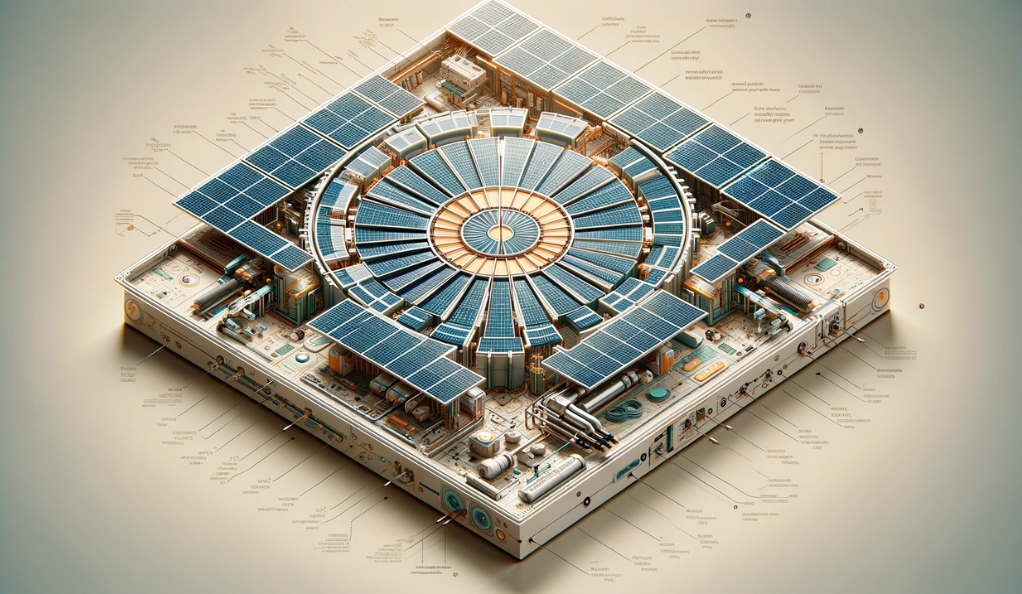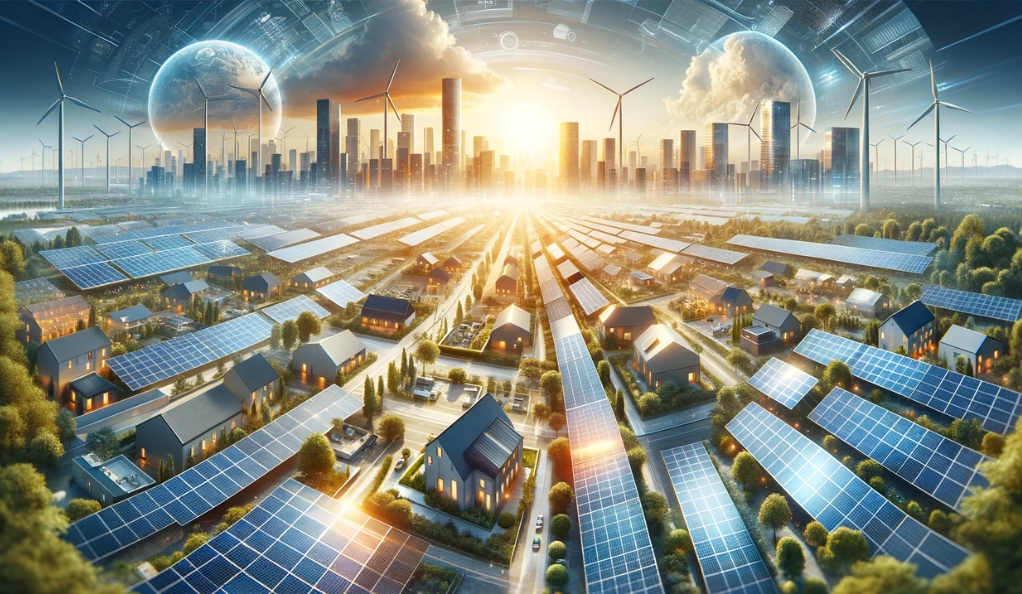The realm of renewable energy is witnessing a paradigm shift with the advent of bifacial solar panel technology. This innovative approach to solar energy harnesses the sun’s power more efficiently than ever before, marking a significant leap from traditional photovoltaic (PV) systems.
Understanding the Basics of Bifacial Solar Panels
At its core, bifacial solar panel technology involves panels that can capture sunlight from both sides. Unlike conventional solar panels that absorb light only on the front surface, bifacial panels are designed with a transparent back layer. This unique structure allows them to absorb direct sunlight on the front and reflected light from the surrounding environment on the back, significantly enhancing their energy-generating potential.
| Feature | Bifacial Solar Panels | Traditional Solar Panels |
|---|---|---|
| Light Absorption | Front and back surfaces | Front surface only |
| Efficiency | Higher (up to 30% more) | Standard |
| Installation Environment | Versatile (ground, rooftops, etc.) | Primarily rooftops |
| Cost | Initially higher, but more efficient | Lower initial cost |
Evolution from Traditional Photovoltaic Systems
The transition from conventional PV systems to bifacial technology marks a substantial progression in solar power. Unlike traditional panels, which mainly harness direct sunlight, bifacial panels capture both direct and reflected light, ensuring consistent energy production even in less-than-ideal conditions. While the upfront cost may be higher, the long-term benefits in terms of energy output and efficiency make bifacial panels a sustainable and cost-effective choice for residential and large-scale solar installations, supporting the goal of maximizing energy yield and reducing carbon emissions.
The Science Behind Bifacial Solar Panels

Bifacial solar panel technology is not just an innovative design; it’s a leap forward in solar energy science. This section delves into the mechanics of how these panels operate and the photovoltaic technologies they employ, offering a deeper understanding of their superior performance.
How Bifacial Panels Capture Sunlight
The key to the bifacial panel’s efficiency lies in its ability to capture and convert sunlight from both its front and back sides. Traditional solar panels have a backing layer that is opaque, designed solely to protect the panel. In contrast, bifacial panels use either a transparent back layer or a series of reflectors that allows light to pass through or get reflected back onto the rear side of the solar cells.
Diagram: Light Absorption in Bifacial Panels
Imagine a cross-sectional diagram of a bifacial panel. Sunlight directly strikes the front, while the back captures reflected light from the ground or surrounding surfaces. This dual capture mechanism effectively increases the panel’s exposure to sunlight, enhancing its energy conversion rate.
Photovoltaic Technologies in Bifacial Panels
Bifacial panels employ advanced photovoltaic technologies to optimize their performance. The most common types of solar cells used in these panels are monocrystalline and polycrystalline cells, known for their high efficiency and durability. Monocrystalline cells, in particular, are highly efficient in converting sunlight to electricity due to their pure silicon construction, making them ideal for bifacial panel applications.
Comparative Advantages of Bifacial Panels
Bifacial solar panels represent a significant advancement over traditional solar technology. This section outlines the key areas where bifacial panels outshine their traditional counterparts, providing a comprehensive efficiency comparison and a cost-benefit analysis.
Efficiency Comparison with Traditional Panels
The most notable advantage of bifacial solar panels is their enhanced efficiency. Traditional solar panels typically convert 15-20% of the solar energy they receive into electricity. In contrast, bifacial panels, by harnessing sunlight from both sides, can boost this efficiency significantly.
Cost-Benefit Analysis
While bifacial solar panels typically have a higher initial cost compared to traditional panels, their increased efficiency leads to greater long-term savings. This is particularly true in areas with high solar irradiance or where ground reflectivity is high.
Integrating Bifacial Panels in Diverse Environments
Another advantage of bifacial panels is their versatility. They are effective in a variety of settings, from large-scale solar farms to residential rooftops. Their design allows for more flexible installation, including vertical configurations, which can be particularly beneficial in space-constrained areas.
Integrating Bifacial Panels in Solar Energy Systems

The adoption of bifacial solar panel technology goes beyond just upgrading the panels themselves; it involves a holistic approach to integrating these panels into broader solar energy systems, including compatibility with solar thermal solutions and batteries. This section explores the practical aspects of such integration and presents case studies to illustrate successful applications.
Compatibility with Solar Thermal Solutions and Batteries
Bifacial solar panels can be seamlessly integrated into existing solar energy systems, including those with solar thermal components and battery storage. This integration enhances overall system efficiency and energy independence.
Bifacial panels’ higher energy yield is particularly beneficial when paired with battery storage systems. The additional power generated can be stored effectively, ensuring a more consistent energy supply, especially during peak demand times or lower sunlight conditions.
Examples Illustrating Successful Integration
Several case studies illustrate the successful integration of bifacial solar panels into diverse settings, showcasing their versatility and efficiency.
- Large-Scale Solar Farms: In regions with high solar irradiance, bifacial panels have been implemented to maximize energy production. Their ability to capture reflected sunlight has led to a notable increase in annual energy yield compared to farms using traditional panels.
- Urban Residential Installations: In urban settings, where space is often limited, bifacial panels have been used in vertical installations on walls or as part of balconies. This approach not only saves space but also contributes to the building’s energy needs more effectively.
- Agricultural Applications: Agri-photovoltaics is an emerging field where bifacial panels are used over agricultural land. The panels provide necessary shade for crops while capturing sunlight from both sides, thereby maximizing land use and energy production.
Environmental Impact and Sustainability
The adoption of bifacial solar panel technology is not just a matter of technological advancement; it’s a significant stride towards environmental sustainability. This section highlights the environmental benefits of bifacial panels, particularly their role in reducing the carbon footprint and promoting long-term ecological balance.
Reduction in Carbon Footprint
Bifacial solar panels contribute to a substantial decrease in carbon emissions, thanks to their higher efficiency and longer lifespan compared to traditional solar panels. By generating more electricity from the same amount of sunlight, these panels reduce reliance on fossil fuels, thereby decreasing greenhouse gas emissions.
Long-Term Environmental Benefits
The long-term environmental benefits of bifacial solar panels extend beyond just reducing carbon emissions. They include:
- Enhanced Energy Yield: Bifacial panels produce more energy per square meter, reducing the need for extensive land use for solar farms. This is particularly beneficial in preserving natural landscapes and ecosystems.
- Reduced Waste: With a longer lifespan and higher durability, bifacial panels contribute to less waste over time. This is crucial in minimizing the environmental impact of solar panel disposal.
- Sustainable Material Use: Advances in bifacial panel technology also focus on using more sustainable and recyclable materials, further enhancing their ecological benefits.
Supporting a Sustainable Future
Bifacial solar panels represent a key technology in the transition to a more sustainable and renewable energy future. By efficiently harnessing solar energy, they offer a solution that not only meets current energy demands but does so in an environmentally responsible manner.
Diagram: Sustainable Energy Cycle with Bifacial Panels
Imagine a diagram illustrating the sustainable energy cycle facilitated by bifacial panels: Solar energy is captured more efficiently, leading to less reliance on non-renewable energy sources, which in turn results in lower carbon emissions and reduced environmental impact.
The Prospects of Bifacial Technology in the Solar Industry
The potential of bifacial solar panel technology in reshaping the future of renewable energy is immense. This section delves into the anticipated advancements in bifacial technology and its expected impact on the global renewable energy market.
Upcoming Advancements and Innovations
The field of bifacial solar technology is continuously evolving, with research and development focused on enhancing efficiency and reducing costs. Future advancements may include:
- Improved Cell Efficiency: Ongoing research is aimed at increasing the efficiency of solar cells used in bifacial panels, potentially leading to even higher energy output.
- Lightweight and Flexible Materials: Innovations in materials science could lead to lighter, more flexible bifacial panels, broadening their application potential.
- Smart Solar Solutions: Integration of smart technology, such as IoT sensors and AI algorithms, could optimize the performance and maintenance of bifacial solar systems.
Potential Impact on Global Renewable Energy Market
The adoption of bifacial solar panels has significant implications for the global renewable energy market:
- Increased Energy Independence: With higher efficiency, countries can move towards greater energy independence, reducing their reliance on imported fossil fuels.
- Economic Growth: The solar industry, particularly in the bifacial panel sector, presents opportunities for economic growth and job creation. As the demand for these panels grows, so does the potential for new companies and employment in manufacturing, installation, and maintenance.
- Sustainability Goals: Bifacial panels contribute significantly to achieving global sustainability goals. Their enhanced efficiency and reduced environmental impact align with efforts to combat climate change and promote green energy.
- Market Expansion: The versatility and efficiency of bifacial panels make them appealing for a range of applications, from urban residential to large-scale industrial, leading to an expansion of the solar market.
Graph: Projected Growth in Bifacial Panel Adoption
Envision a graph showing a steady upward trend in the adoption of bifacial solar panels over the next decade. The graph would illustrate increases in both residential and commercial sectors, highlighting the growing recognition of their benefits in the renewable energy market.
Driving the Renewable Revolution
Bifacial solar panel technology is not just an emerging trend; it’s a key driver in the renewable energy revolution. As technology advances and awareness of its benefits grows, we can expect to see a significant shift in how solar energy is harnessed globally.
Conclusion
The bifacial solar panel technology marks a significant milestone in renewable energy advancement. Its superior efficiency, environmental sustainability, and potential for future innovations position it at the forefront of the solar industry’s evolution. By harnessing sunlight more effectively and offering versatile applications, bifacial panels pave the way for a greener, more sustainable future. Embracing this technology not only addresses current energy challenges but also sets a foundation for a cleaner, energy-independent world.
